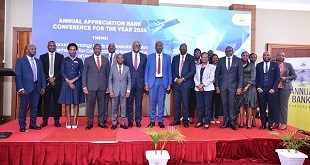
The lender will now focus on technology usage, human resource capabilities and credit earnings from agriculture, manufacturing sectors to drive growth
Kampala, Uganda | JULIUS BUSINGE | Bank of Baroda Uganda Limited, a subsidiary of Bank of Baroda, India is focusing on investing in technology to offer efficient and timely services to customers but also to manage operational costs.
Kumar Meena, the bank’s managing director told shareholders during a virtual annual general meeting in Kampala on Sept.18 that the bank has embarked on putting in place cash recycler machines to replace ATMs to serve customers on a 24/7 basis with cash deposit facility as well as strengthening its risk management systems to prevent losses that might emerge out of its operations and compromise profitability.
He said the bank also plans to improve on its human resource capabilities by retooling/reskilling its human resource base in line with emerging industry issues, strengthen and expand operations for internet and mobile banking as well as enhance its customer service.
Meena revealed that the bank has been extending a significant portion of its credit facilities to two main sectors of the economy – manufacturing and agriculture.
For instance, last year, it extended 38% of its credit to manufacturing, up from 35% in 2018, and did extend 28% of its total credit to agriculture in 2019, higher than 25% in 2018.
In addition to the other sectors, Meena said they will extend more credit to these sectors depending on the need and risk assessments of clients.
The bank’s top officials are also pegging their growth prospects on government’s continued investment in high profile infrastructure projects and related sectors like oil and gas. It also sees mega opportunities in the inflow of foreign direct investments, continued growth in the service, education and health sectors.
Meena also said the bank will uphold high corporate governance principles to drive growth of the bank. The other key area of consideration is cutting operational costs by attracting affordable customer deposits and relying heavily on technology to deliver services.
“We will do all this using a diversified business model that balances the interests of shareholders, customers, employees and communities,” he said.
Meanwhile, a member of the board and top economist, Fred Muhumuza, who also lectures economics at Makerere University, said the bank did not pay any dividends to shareholders for the year 2019.
He said, this was in response to the Bank of Uganda’s directives to lenders under its arm not to do so in a bid to maintain strong liquidity status as the country battles the negative effects caused by COVID-19 on businesses and the economy at large.
“But your money is retained,” Muhumuza said. “We want to assure you that come next year we will pay higher dividends. Let’s wait for guidance from Bank of Uganda,” he added.
The Board had recommend a dividend of Shs25billion for the year ended December 31, 2019, translating into Shs10 per share.
Strong performance?
According to its financial statements for the year ended December 2019, top management said, the bank as a whole made a strong foothold with a solid foundation, excellent industry position and opportunities for growth.
They said the year 2019 was a productive year for the bank and they achieved good business growth during the year.
Total deposits increased by Shs136.41bn, showing a growth of 10.48% over the previous year, advances net of impairment increased by Shs47.08bn showing a growth of 6.22% in 2019. In general, total business covering deposits and advances increased by Shs184.72bn showing a growth of 8.94% over the previous year.
The other highlights are; total assets increased by 9.43% in 2019 to Shs1.8trillion from Shs1.7trillion in 2018. Total income increased by 2.17% to Shs199bn in 2019 from Sh195bn in 2018. Profit after tax decreased by 38.28% in 2019 to Shs45bn from Sh73bn in 2018. Gross non-performing loans as a percentage to total advances was at 1.25% as of December 2019 which is below the industry ratio of between 4-55% in the year.
“We aim to expand our footprints in the emerging markets by leveraging our strong position in the existing markets within the country,” the executives said.
****
 The Independent Uganda: You get the Truth we Pay the Price
The Independent Uganda: You get the Truth we Pay the Price


